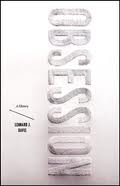 Davis, Lennard J. - Obsession: A History, The University of Chicago Press, Chicago and London, 2008 (pp 296) ISBN-10: 0226137821
Davis, Lennard J. - Obsession: A History, The University of Chicago Press, Chicago and London, 2008 (pp 296) ISBN-10: 0226137821
To be obsessive is to be modern, argues Lennard Davis in Obsession: A History. “We live in a culture,” Davis writes, “that wants its love affairs obsessive, its artists obsessed, its genius fixated, its music driven, its athletes devoted. We’re told that without the intensity provided by an obsession, things are only done by halves. Our standards need to be extreme, our outcomes intense.”(p.4)
Indeed, we only have to consider our collective celebration of real-life people with a driving, single-minded focus, from Olympic medallists to inventors. But Davis’s main thesis, which he makes compellingly in this intellectually bold crossover text, is that one cannot understand obsession without considering its corresponding social, cultural, historical, anthropological and political circumstances.
Readers of Susan Sontag will be familiar with the idea of disease as metaphor and while obsession may be a phenomenon of modern existence, it can also be much more than excessive interest or preoccupation. It is also an illness: a pathology. Davis makes it clear that he believes OCD to be a real disease which causes pain and suffering to those diagnosed, however his book is concerned with tracing the history of the Western world’s interest in obsession, “both as a cultural goal and feature of modernity” (p.11) as well as a pathology.
Interestingly, to me at least, it was Davis’s very intent that had one reviewer’s nose out of joint. Writing for online publication The Huffington Post, a reviewer (who is also a neurologist it must be noted), took umbrage with what he considered Davis’s mistake of trying to cross the line between science and the humanities. In the reviewer’s opinion, doing so either satisfies neither side, or else only one side. And it’s unlikely to be the science side.
Good heavens. This may be outrageously postmodern and inter-disciplinary of me, but what tosh. Then again, I do work in the humanities. The reviewer seemed offended by Davis’s aim to show obsession on a continuum – from obsession in culture to obsession in an individual – and said that there: “is no useful point in blurring the distinction between obsession as a clinical diagnostic entity in psychiatry and obsession as a description for certain kinds of behaviours that can be extremely productive”. He goes on to point out that the clinical entity, OCD, involves serious dysfunction and that nearly 70 percent of OCD patients go on to suffer major depression.
True, but at no point in the book does Davis indicate, or even intimate, that he does not consider OCD to be a serious and debilitating illness. The reviewer missed the point of the book – Davis does not want “more attention paid to history and literary allusions to obsessive behaviour and obsessive characters” as asserted by the reviewer, but rather wants to look at a modern phenomenon from another perspective. The importance of doing so is ably justified in the book, including a need for the humanities to comment and analyse the implications of scientific discoveries.
Davis is Distinguished Professor of Liberal Arts and Sciences in the Departments of English, Disability and Human Development at the University of Illinois in Chicago, and a pioneering scholar in the field of disability studies. In an interview published on the University of Chicago Press’s website, Davis argues: “I think we can learn a lot more not only about OCD but the way we categorize and delimit psychiatric disorders if we allow a flow from the harmless eccentricity to the serious illness, from the growth of obsession as a cultural category to the rise of the disease”.
One of the main questions he posits in the book is: if OCD is a brain disease that has always been around and is therefore relatively independent of culture, then how can the brain scientists explain the significant rise in the incidence of the disorder? He goes on to detail a complex mix of cultural, economic and political factors.
Beginning with the roots of the disease in demonic possession, Davis uses a wide range of historical, cultural and medical sources and examples drawn from biography, literature, art, psychology, and the history of scientific research. Charles Dickens's accounts of coming into contact with monomaniacs during visits to asylums is detailed, and Mary Shelley's Frankenstein is considered an early example of fictional characters obsessed with single goals such as the creation of new life. The book is full of rich examples exemplifying obsessive people and their work.
It was not until the late 19th century, as the scientific revolution began to grip the world, that obsession became “a secular, medical phenomenon”, (p.6) Davis writes. The analysis of the increased number of people being diagnosed with OCD within the past 30 years is a strength of the book. While, as pointed out earlier, Davis takes such illnesses seriously and deals with them sympathetically, he makes a compelling argument about disease being much more than a physical condition.
An engaging historical tour of a fascinating subject.
About the author
Milissa Deitz is a journalist and novelist with a PhD in Media and Communications from the University of Sydney. Her books Bloodlust and My Life As A Side Effect are both published by Random House. Her book Watch This Space: The Future of Australian Journalism was published by Cambridge University Press in 2010.

